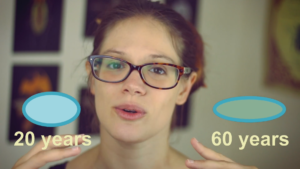All Draw Curiosity videos are fully subtitled in English and Spanish. The blog post builds on the concepts touched upon in the video.
Vision is a fascinating topic to me. I’ve previously covered the fascinating way that cephalopods can detect colour without colour vision, but I think there is also appeal in speaking about our own vision – especially when there are many features about it that we are mostly unaware of. In this video I’ve covered four aspects pertaining to our eye structure (versus the processing that later goes on in the brain) which could have a ‘better design’.
The Lens
Our eyes focus in a different manner to camera lenses. Camera lenses use motors to change the distance in between the different lens pieces, allowing the light to focus in different ways. We are unable to shift our lens backwards and forwards inside our eye, so instead the ciliary muscles alter the lens’ shape.
The lens is made out of concentrically layered crystalline cells, and these layers are added at a slower rate throughout our life. Unfortunately, after birth, the capillaries that once supplied nutrients to our lens atrophy, and they receive their nutrients via diffusion from the aqueous humour. When the lens becomes so thick that the cells in the centre can no longer receive nutrients, they die and their physical properties change. This leads to a stiffer lens and presbyopia.

Changes in lens properties are also linked to changes in opacity and the development of cataracts, although the full relationship is not yet completely understood.
Does Sunlight Really Affect Eye Growth?
In short: yes.
There is a Danish study which presents a strong case for this statement, which can be read here: “Effect of day length on eye growth, myopia progression, and change of corneal power in myopic children” by Cui D., Trier K. and Munk Ribel-Madsen S. 2013
The study demonstrates that the amount of daily sunlight received affects how much the eye grows. The amount of sunlight per day in Denmark, which is situated at quite a northern latitude, oscillates between 7 and 17.5 hours over the course of the year, which is quite a large range when compared to my hometown Seville, which receives between 9 and 14.5 hours per day, or the tropics, which receive around 12 hours all day round. The researchers found that lengthening of the eye, which is linked to myopia, occurred much faster when less sunlight was received versus periods where the kids were exposed to more sunlight. As a result, young children are encouraged to spend more time outdoors to reduce the chances of developing myopia, although the surge in technology over the past 20 years is actually more likely to encourage children to spend more time indoors.
How Can I Find My Blindspot?
Most of the time you will be unaware of the presence of your blindspot because it lies outside of the macula, which is the area of the eye with the highest resolution and where we focus most of our attention. The blindspot isn’t all the way out into peripheral vision, but somewhere in between, which allows the brain to do a great job at filling in the blanks. Additionally, most of us will have two eyes and functional binocular vision, so the brain can easily fill in the blanks using the information from the other eye as well.
However, you can find your blindspot by looking at these grids! Place your head approximately 3 times the distance between the dots away from your computer screen. Cover the eye indicated in the caption and look at the x. Adjust your head until the dot disappears – you will have found your blindspot!


You can try more elaborate grids and look at each one to see if the blindspot disappears too. That way, you can make a slight estimate of the shape and size of your blindspot. It will be less accurate in terms of size as that depends on the exact distance between the screen and your retina, which I don’t know, but it is still a fun experiment. Apparently the blindspot gets larger with age.


I found this to be quite insightful, my blindspot appears to be taller than wide according to this test. What does yours look like?
I hope you enjoyed and learned something new today! Let me know what you think in the comments – I would love to know! If you enjoyed this blog and would like to be notified of new entries, consider signing up to the mailing list here and subscribing to the YouTube channel!

Get your PhD completed as quickly as you can and get into science communication 😉
Hannah Smithson from Pembroke Oxford has access to Adaptive Optics Scanning Laser Ophthalmoscopy. It is kind of cool. I went to a summer school in Oxford, and got my retina scanned. I don’t know if you want to make a video about that. I reckon that would be your coolest video.
That does sound very interesting – I have quite a few ideas on videos about vision and I’m based in Oxford so I will certainly contact her. Thank you very much for this and I hope you enjoyed the Summer School – I’ve heard a lot about the Oxford summer schools at Pembroke and St. Peters College!
I went to the International Colour Vision Society Summer School. Hannah Smithson was organising it. She’s based in Pembroke Oxford, hence we stayed in Pembroke Oxford. The summer school itself was really nice, I learnt a lot of cool stuff.
You can actually see individual cones and rods with Adaptive Optics Scanning Laser Ophthalmoscopy (AOSLO). It is basically running confocal microscopy on your retina.
She has other interesting experiments too, for the undergraduates. I am pretty sure she would be happy for you to make a video. It is basically free advertising for her.
I sent her an e-mail following your comment! 🙂
Hopefully this will happen – it sounds fascinating and her work is exactly the type of research I’m interested in. Thanks for letting me know about it!
Great! Do let me know if you manage to get access to the machine. 🙂
Four Eyes Our Ways Are Flawed
>Unfortunately, after birth, the capillaries that once supplied nutrients to our lens atrophy
Unfortunately? Maybe we wouldn’t see well through the capillaries. I don’t think the body removes them for no reason.
I’m surprised to hear that the lens continues to grow. Our eyes don’t grow much, do they? Isn’t that the reason why they take up so much space on kid’s faces?
With regards to the capillaries, that is a good point – the hyaloid artery is the one that supplies the eye during foetal development, and in the final weeks of gestation it tends to regress. If it doesn’t, it can lead to floaters (discussed here) and other visual impairments.
That being said – we do have capillaries in front of our retina – as do many other animals and our brain can deal with it, so I wouldn’t have thought doing the same with a lens would be much harder. :p Ideally, these capillaries would supply the lens from the side, as opposed to on the plane where light enters the eye too.
And yes, the lens do continue to grow throughout our lives – it’s a slow process, and the layers laid down are very fine and densely packed so it probably doesn’t affect overall size in a significant manner, but it would affect how well the central cells receive nutrition. Our eyes don’t really grow after adolescence. Part of the reason for this difference is that different parts of the eye come from different stem cells during development. Most parts of the eye come from the neural crest ectoderm (in general, cells from here make up the nervous system + facial features), whereas the lens comes from surface ectoderm (these cells generally form skin and other ‘surface’ tissues), and are basically modified epithelial (skin) cells). It’s not unusual for cells to grow and multiply throughout our lives as it is a key part to regenerating tissues, and certain tissues do grow (ears and nose cartilage for instance). In the case of the lens, the flaw is the new layers are placed outside, and the eye is such a closed system that it is hard to flush out or reabsorb debris that comes loose within. Therefore, the older inside cells have nowhere to go – and the cells in the very centre of your lens, which will have originated from the original foetal nuclei, could very well be the oldest cell in your body 😉
This is a somewhat simplified explanation, if you’re interested in the topic I can recommend searching on Wikipedia or in journal articles about human lens histology and eye development to find out how the three different lens cell type grow and behave from foetal all the way through adult life.
– Inés